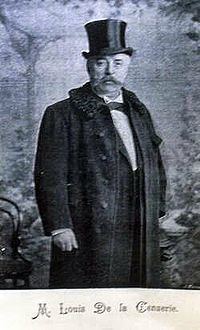Nationality Belgian, Occupation Architect | Name Louis Delacenserie Role Architect | |
 | ||
Buildings Central Station in AntwerpSint-Petrus-en-Pauluskerk in Oostende Structures | ||
Louis Delacenserie (1838–1909) was a Belgian architect from Bruges. The spelling of his name differs greatly; De la Censerie, Delasencerie, Dela Censerie or Dela Sencerie are the most common alternative forms. His father was a merchant and building contractor from Tournai.
Delacenserie studied architecture at the Académie of his native city under Jean-Brunon Rudd (1792–1870). He was a laureate of the Prix de Rome in 1862. This prize enabled him to travel to Paris, Italy and Greece where he could admire masterpieces of antique architecture. After his studies he worked for a while in the office of Louis Roelandt, architect to the city of Ghent who worked in the Neo-Classical style. In his early career Delacenserie adopted the Neo-Classical style of his teachers. After he was appointed architect to the city of Bruges he became involved in the Belgian Gothic Revival movement. He led many "restorations" of the rich Gothic architectural heritage of his native city. This made him familiar with the Gothic brick and sandstone architecture of medieval Flanders. Thanks to his profound knowledge of medieval architecture he was able to imitate this historic style in all its details although he often used new construction techniques and materials in his own original creations.
At the pinnacle of his career Delacenserie made the designs for the central station in Antwerp. In this design he made use of a rather eclectic Neo-Renaissance style that refers to the economic and artistic prime of the city in the 16th century. Some aspects of this edifice, like the use of colours and materials, were clearly influenced by Art Nouveau architecture.
Works
Some restoration projects in Bruges:
Some of his new original projects:
